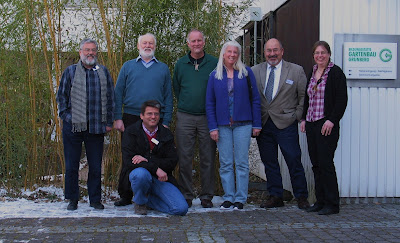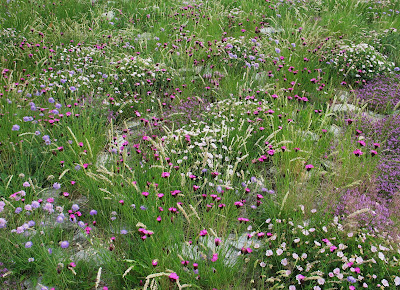From the left, Ray Stephenson, Ron McBeath, Ed Snodgrass, Tammi Hartung,
Panayoti Kelaidis, Susan Band, sitting infront, Georg Uebelhart
For the fifth year in a row a winter conference on perennials has been hold at Die Bildungsstätte Gartenbau in Grünberg in Germany. As usual, George Uebelhart had put together the exellent program and he also acted as moderator during the three days, Friday-Saturday, last weekend.
Ron McBeath from Lambereton Nursery in Scotland gave two talks, one on plant hunting and plants in the Himalayas, Sikkim, Nepal and China and one on rock plants, and he showed beautiful pictures of the high mountains and Primula, Meconopsis, Gentiana and other plants.
Together a total of three educational lectures on plants from both alpine and subalpine environments as well as other mountain plants. Particularly, I now feel tempted to some time go myself to the Himalayas.
Nomocharis pardanthina. Photo from The Alpine Garden Society
Rhodiola bupleuroides, male plants. From The Sedum Society Newsletter
In the late afternoons till early mornings, in the cozy German Bierstube, the vague memories of today's lectures were diluted by chilled and tasty beer.
Since all the lectures were interesting, it is difficult to select a single presentation that would be better than any of the others, but when Ed Snodgrass began to show pictures of roof gardens and mentioned their importance to biodiversity I smiled contentedly inside where my heart is situated.
This was the fifth perennial conference and Ed Snodgrass is also a fifth generation farmer and nurseryman, and the president and founder of Emory Knoll Farms in Maryland, US. He is the co-author of the books Green Roof Plants: A Resource and Plant Guide (2006) and The Green Roof Manual: A Professional Guide to Design, Installation, and Maintenance (2010).
Green Roof Plants at Emory Knoll Farms in Maryland. Photo: Emory Knoll Farms, Inc
Panayoti Kelaidis is a true plant lover and a devoted collector, and when he lined up image after image from beautiful Colorado, I felt quite quickly that there I have to go. He has written several books such as Flourish: A Visionary Garden in the American West and participated with his brilliant photographs in others as in the monograph Penstemon by Robert Nold.
Tammi Hartung told us about the use of herbs in food and as health supplements. That is an area that particularly interests me and for me there were therefore many familiar plants she talked about, but also some more unusual and less known. Tammi gave us several recipes that we could try at home. More recipes can be found in her books Homegrown Herbs: A Complete Guide to Growing, Using, and Enjoying More than 100 Herbs and Growing 101 Herbs That Heal: Gardening Techniques, Recipes, and Remedies.
On the whole, this year's ISU conference was very successful and we got all really inspired so now I am already looking toward next winter, and the sixth perennial conference. But as early as this August the ISU congress is held in the Netherlands. See you there?
The informal talks are equally important and fun as the conference itself













